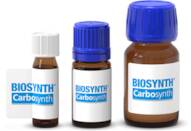Bisnorcholenaldehyde
CAS : 3986-89-8
Ref. 3D-DAA98689
| 10mg | Arrêté | ||
| 25mg | Arrêté | ||
| 50mg | Arrêté | ||
| 100mg | Arrêté | ||
| 250mg | Arrêté |
Informations sur le produit
- (2S)-2-[(8S,9S,10R,13S,14S,17R)-10,13-dimethyl-3-oxo-2,3,6,7,8,9,10,11,12,13,14,15,16,17-tetradecahydro-1H-cyclopenta[a]phenanthren-17-yl]propanal (non-preferred name)
Bisnorcholenaldehyde is a synthetic compound that has been used in the preparation of vitamin D3. It is adsorbed onto silica gel using an adsorption isotherm and desorbed from the gel by acetonitrile. The filtrate obtained after the adsorption process was evaporated to dryness, and then the product was purified by preparative high-performance liquid chromatography (HPLC). Bisnorcholenaldehyde can be synthesized from glycerol and succinic acid via an oxidation reaction. The synthesis of bisnorcholenaldehyde is catalyzed by copper ions and molecular oxygen. This process involves three steps: 1) the addition of molecular oxygen to glycerol, 2) dehydration of the resulting alcohol, 3) coupling with succinic acid. Bisnorcholenaldehyde has been shown to have good adsorption kinetics for vitamin D3 in urine samples.





